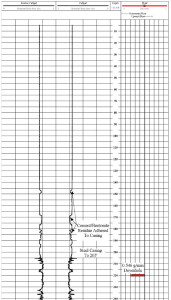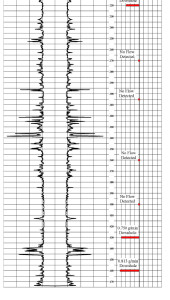Challenge
Mundell was retained by an environmental consultant to conduct an evaluation of groundwater flow conditions in the limestone bedrock beneath a former industrial facility in Sullivan, Missouri. It was believed that a chlorinated solvent spill was being transported in the local bedrock via fracture zones. .Thus, Mundell was asked to detect the localized fracture zones using downhole geophysical methods.
Action
The geophysical testing was conducted in one, six inch diameter borehole, cased from 0 to 205 feet and open from 205 to 475 below ground surface. The downhole logging in the borehole consisted of a three-arm caliper log to measure the diameter of the hole and indicate where the bedrock is weathered and fractured, a video log to visually inspect the bedrock and characteristics of the fractured/weathered intervals, and a heat pulse flow log
to quantify the vertical movement of groundwater under unstressed, ambient flow conditions. The downhole logging was conducted using a portable MGX logging system manufactured by Mount Sopris.
Results
The caliper log (presented with both the original and mirror image to show repeatability) indicates that several fracture zones are present in the bedrock, with the greatest fracturing occurring beneath 300 feet of depth. Video inspection of the hole confirmed the presence of these zones of fracturing/weathering. The flow log indicates that in general, the upper 400 feet of the borehole are under stable flow conditions, and that flow is downward beneath 420 feet, increasing in magnitude towards the bottom of the hole. This is due to an inflow of groundwater from the fractures at that depth interval, which may be transmitting the chlorinated solvent impacts.





